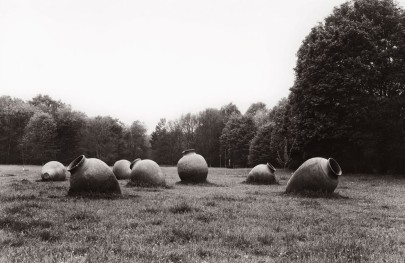With the “Lichtwiese Sculpture Garden”, a project has been gradually realised for several years, the aim of which is to enhance the design of the new development area of the TH Darmstadt on the Lichtwiese by means of specifically selected and placed sculptures. The starting point for the considerations were some works of art already purchased with funds for art in construction. Objects such as the “Marsays” by A. Hrdlicka, “Kugel/Kegel” by Fr. Koenig and the “Linear House” by the artist group Haus-Rucker provided decisive impulses for the attempt to enliven the grounds, which are occupied by angular institute buildings, with a sculpture garden. Visual relationships between the sculptures are intended to link the neighbourhood and create experiential spaces that counteract the anonymity of the new development area. Therefore, the intention is not to establish a museum for contemporary sculpture, but to use works of art to make the space, which is characterised by landscape elements and institute buildings, more experientially aware and to enhance it.
The concept underlying the project is based on the assumption that the individual sculptures do not only stand for themselves in a defined space, but that visual relationships to other sculptures encourage visitors to move within the sculpture garden. The exhibition of sculptures is oriented less towards a predefined system of paths than towards spatial contexts within which the visitor determines his or her own path. This can give them the chance to become, as it were, the director of a production that opens up the sculpture garden to them without didactic paternalism.
The concept deliberately avoids prescribing a fixed plan with certain sculptures for fixed locations. Instead, a new decision is made in each case to react to given situations, which are also influenced by sculptures that have already been set up. The selection of individual works of art is based neither on style nor theme, but solely on quality criteria. In addition, the sculptures benefit from the fact that the artists themselves suggest the respective location, so that the installation becomes an integral part of the artworks.
The Hessian Ministry of Finance and an advisory board supporting the Ministry approved this concept, which was supported by the President and Chancellor of the TH Darmstadt, included the sculpture garden in a corresponding programme of the State of Hesse and has since decided positively on the applications submitted for funding. In addition, the city of Darmstadt and private sponsors have contributed to this project. In this way, it has become possible to set up a number of sculptures so that the sculpture garden reveals certain fixed points. These include the sculpture “Bedrohter II” (Threatened II) by W. Grzimek, which was erected in 1989 on the path leading from the architecture building to the Mensa. This was followed a year later by the double relief “Grosse Frauenfigur im Rombus” by W. Loth and in 1993 by the statue “Erde” by Th. Duttenhöfer. In the same year, a sculpture event took place on the Lichtwiese, during which several wooden exhibits were created. Some of these works could be acquired for the sculpture garden. This concerns the “Temple Tree” at the hillside meadow by C. Bury, the “Arrangement with Large Clay Vessels” at the northern end of the Sculpture Garden by F. Stähler, the “Double Gate” at the Small Forest in the west of the Lichtwiese by J. Carter and by K. Simon the “Composition with Tree Trunks” next to the terminus of the L bus line.
Although the Lichtwiese Sculpture Garden project has not been completed with the inventory realised so far, the concept envisages the installation of only a few sculptures. The idea is to avoid filling up the site arbitrarily or furnishing it excessively. If it is possible to enliven the new development area with accentuating sculptures and to counteract the anonymity of the rather sparse building volumes in order to create spaces that can be experienced, the goal pursued with this sculpture garden will be achieved.
from: versus, Forum for Architecture 1, 1995







